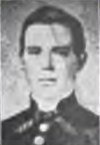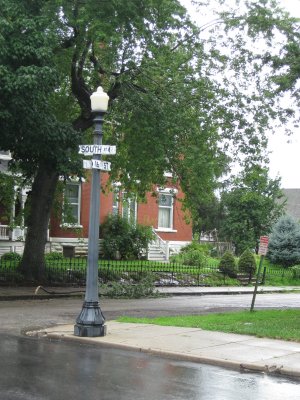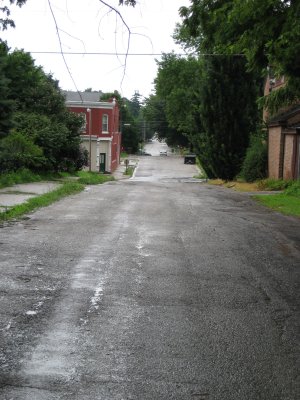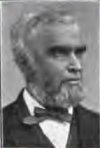Clark's Battery
Tour Stop
 Directions: The stop for Clark's Battery [ Waypoint = N39 11.006 W93 52.603 ] is located at the corner of South and 16th Streets in Lexington, Missouri 64067.
Directions: The stop for Clark's Battery [ Waypoint = N39 11.006 W93 52.603 ] is located at the corner of South and 16th Streets in Lexington, Missouri 64067.
Exit Machpelah Cemetery and turn left (north) onto 20th Street. Proceed about 0.2 miles to the first stop sign and turn left (west) onto South Street. Proceed about 0.3 miles to 16th Street. Stop and find a place to park. Since there is no parking on the north side of the street, your best bet is to turn around and park on the south side of the street heading east. Please be aware that this location is private property.
Description: Nineteen year old Captain Churchill Clark, grandson of explorer William Clark, was in command of a three gun battery in Brigadier General James S. Rains' 8th Division. He deployed a brass 6-pounder gun at this location and fired at the Masonic College building which was being used as the Federal headquarters.
 |
 |
The Chief Ordnance Officer for the Missouri State Guard, Colonel J. F. Snyder later described Captain Clark and the shelling that took place at this location:
"...a sprightly, wideawake young man came to us and asked if we had any "undersized" six-pound shot. Though hardly more than a boy, he was an artillery officer named...Churchill Clark. I happened to have what he wanted, balls cast somewhat less than the standard size, and glad to get rid of them. He was planning to burn Fort Mulligan [the Masonic College building], and, not then assigned to any special duty, I accepted his invitation to help him. Near the corner of a row of brick houses, on a cross street, he had a brass six-pound gun, and nearby rigged up a blacksmith's forge for heating the iron shot. ... With plenty of coal and men to ply the bellows, the shot were readily super-heated. The gun, with a charge of powder in place, was then quickly wheeled out in range, and, with proper elevation, aimed at the [Masonic College]. ... The young officer sighted his gun well. Several balls going through the gable struck the rafters and fell to the floor below, but the vigilant soldiers at once caught them up and threw them out the window."
 Union Major R. T. Van Horn later described this event from the Federal vantage point inside the Masonic College building:
Union Major R. T. Van Horn later described this event from the Federal vantage point inside the Masonic College building:
"I will recite [an] occurrence illustrative of personal coolness and bravery--this time in a boy not over 12 or 14 years old. I happened to be in command of that part of our lines including the college building, in which were stationed Col. Robert Adams' sharp-shooters. Bledsoe's battery was stationed some blocks away, and fronting the building. One of the sharp-shooters called to me, saying that red-hot shot was being used to fire it. On going into the building on the second floor I saw the smoke rising from where a six-pound ball had fallen. As the tools for throwing up the breast-works were near I took a shovel and threw the ball out of the window. Just then a boy came up and said: "I can do that." I looked at the lad, a mere "kid," as we call the small boy, and said to him: "Do you think you can?" Of course he was confident. By this time another shot came crashing through the front wall and fell in on the floor. He at once grasped the shovel and threw it out. As I was needed other-wise, I showed him how to shelter himself and watch the flash at the battery and wait for the ball to strike, and gave him the job. As long as the shot were fired he threw them out, cheeringly calling attention to each as he did the work. Being in the hospital at the surrender I was unable to find him, or to know where he belonged, and did not even know his name--and I regretted that I was not to know who he was or where my little hero belonged." [Note: the young man's name was Charles A. Lantheaume]
Back: Machpelah Cemetery
Next: Bledsoe's Battery
